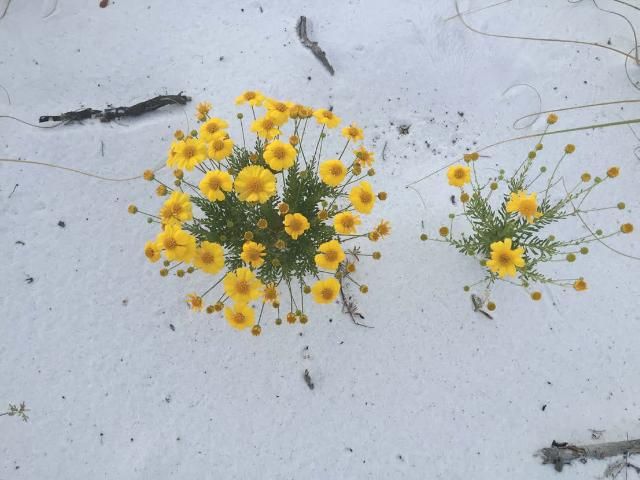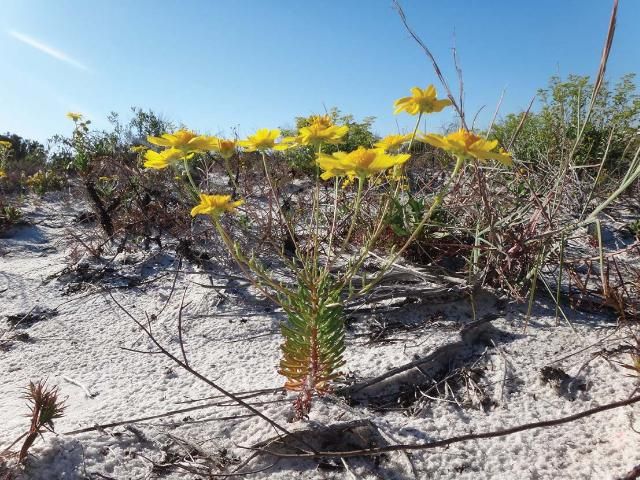Note: This fact sheet is also available as a chapter in a comprehensive manual titled Dune Restoration and Enhancement for the Florida Panhandle, available in pdf form here: https://edis.ifas.ufl.edu/pdffiles/SG/SG15600.pdf. Please see the manual for more information about other useful and attractive native plants for dunes and for further information about restoration and preservation techniques.
Asteraceae

Credit: Gabriel Campbell, UF/IFAS
Coastalplain honeycombhead is found in beach dunes, coastal grasslands, and scrub throughout Florida and into Alabama and Mississippi. It is a prolific flower and seed producer that attracts numerous pollinators, including the gulf fritillary butterfly. Interestingly, the endemic, solitary, and ground-dwelling coastal plain Hesperapis (Hesperapis oraria), also known as Balduina bee, is completely dependent on the coastalplain honeycombhead for survival, only emerging from the ground a few weeks each year in September to October to collect pollen and nectar (Hunsburger 2013). This bee only occurs on barrier islands and peninsulas in the northern Gulf of Mexico (Hunsburger 2013) and is particularly vulnerable to climate-change-driven sea-level rise and habitat fragmentation.
General Description
Coastalplain honeycombhead is an herbaceous, widely branched annual to biennial that can reach heights of 1 meter but often is much shorter in coastal plant communities. Leaves are entire, simple, narrowly linear, up to 2 in long, and alternate. Inflorescences occur en masse during the summer. Inflorescences are branched corymbs when not solitary. Heads contain ray flowers up to 0.8 in long with yellow rays and disk flowers up to 4 to 5 mm long, also yellow. When dry, mature heads are viewed from above, chambers in the head take on the appearance of cells in a honeycomb. Chambers appear white and contain easily identifiable fruits. Fruits are achenes typically no longer than 2 millimeters. Seeds are black with an attached whitish grey 2-mm-long pappus with round scales.
Propagation
Cutting propagation of coastalplain honeycombhead is possible with an application of 5,000 ppm IBA (Indole-3-butyric acid) recommended for optimal rooting response. Apical stem cuttings taken during June to July should achieve at least 80% rooting and produce about 15 roots per cutting (Wilson et al. 2010).

Credit: Gabriel Campbell, UF/IFAS
Propagation from seed has also been studied. Seeds of coastalplain honeycombhead are physiologically dormant and need a period of cold stratification for germination (Pérez 2007; Wilson et al. 2010). Seeds possess a non-deep physiological dormancy and have up to 80% germination with exposure to alternating day/night winter temperatures of 22/11°C for about 4 to 5 weeks. Natural germination should occur in the spring.
Seedlings can be grown in greenhouses. The following is adapted from Smith et al. (2014) for the production of plants in 1-gal pots for ornamental plantings. Transplants may be placed in smaller containers for a shorter production period if used for reestablishment of this species for restoration purposes.
Plant seeds in germination media within 6-cell packs where they can remain for 4 weeks or until they form cohesive rootballs. Plants may be transitioned to outdoor, full sun culture and moved up to 1-gal pots within a well-drained media, such as Atlas 7000, for an additional 16 weeks of production. Production in smaller containers or production of smaller vegetative transplants for restoration plantings will shorten the production period.
Outplanting
This species has successfully been transplanted (20-week-old seedlings) from a container (1-gal pot) when grown in a well-drained substrate (Atlas 7000), and performed well in a trial garden as a native wildflower producer for several months (Smith et al. 2014). This species is an annual and needs to be transplanted early in the growing season so it is established before floral initiation. The species is also known to be an obligate outcrosser. Multiple plants will need to be established in close proximity to ensure pollination among container-grown plants to encourage seed production and natural recruitment the following season in the restoration area where planted.
Literature Cited
Hunsburger, H. 2013. "Distribution and habitat use of Florida endemic solitary bee Hesperapis oraria and host plant Balduina angustifolia." Master's thesis. University of Florida.
Pérez, H.E. 2007. Final Report FWAC Grant #R-006-06. 3 p. Smith, A.M., S.B. Wilson, M. Thetford, K.L. Nolan, and C. Reinhardt Adams. 2014. "Performance of nine Florida native wildflower species grown in varying container substrates." Native Plants Journal 15(1):75–86.
Wilson, S.B., H. Perez, and M. Thetford. 2010. Propagation, Production, and Landscape Evaluation of Native Wildflowers in West, Central and South Florida. Condensed Progress Report for the Florida Wildflower Foundation. https://www.flawildflowers.org/wp-content/resources/pdfs/Research/Wildflower%20year-end%20progress%20report-Wilson%20et%20al.pdf